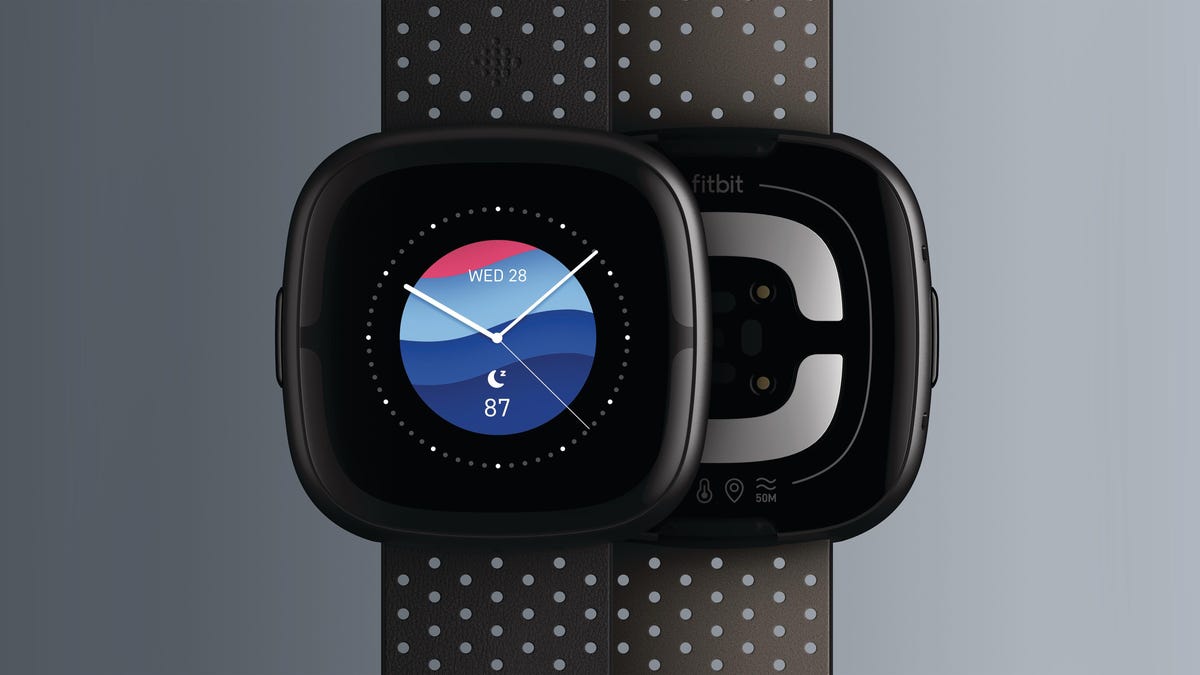 Why You Can Trust CNET
Why You Can Trust CNET Fitbit Sense 2 Arriving This Fall for $300, With All-Day Stress Sensor
Here is how Fitbit's sensor-studded watch may differ from the Pixel Watch.

The Fitbit Sense 2 adds new rear sensors and a redesigned look.
Fitbit, now a part of Google, is working on developing the Pixel Watch this fall. But there are also other new Fitbits, as Fitbit head James Park told CNET earlier this year. The Fitbit Sense 2, a sequel to the sensor-packed Sense watch released two years ago, is arriving this fall alongside a GPS-equipped Versa 4 watch and a new $99 color-screened Inspire 3.
Where the Sense 2 may most differ from the expected Pixel Watch is in its use of a wider range of sensors, while keeping compatibility with both the iPhone and Android phones.
The original Sense added skin temperature sensing, a feature that's since been used in wearables like the Samsung Galaxy Watch 5 and is expected on the next Apple Watch. It also had an electrodermal activity sensor that aimed to measure stress levels through palm contact with the watch face. Both those features are now on the smaller, less-expensive Fitbit Charge 5.
The $300 Sense 2 adds another type of sensor tech Google and Fitbit are calling cEDA, or "continuous electrodermal activity." The previous Sense watch had to rely on spot checks with the EDA sensor to look for possible signs of stress, while the Sense 2 promises to scan continuously with a rear electrical sensor, combining with the optical heart-rate sensor to look for daily moments where possible stressors might pop up.
According to Fitbit, these possible stressor moments are then flagged by the watch's software interface via pop-up notifications, which can be set to happen instantly or be summarized later in the day. It's not exactly clear what these signs of stress amount to in daily use, but Fitbit emphasizes that the goal is to raise awareness of when the moments are happening.
The cEDA metric is the third type of stress measurement Fitbit will have on its watch; the Sense 2 will still also do spot checks with the EDA sensor, which Fitbit says is a different type of stress measurement. Fitbit also calculates a daily Stress Management Score, which doesn't need Fitbit's EDA sensor.
An exploded look at the sensors of the Fitbit Sense 2.
Much like Samsung's body analysis sensor on its watches, it's not clear how exactly these sensors will be used over time or how effective they'll actually be. I found I stopped doing spot-checks with the Fitbit Sense EDA sensor when I wore it for longer periods, but it sounds like the Sense 2's new always-on mode for stress sensing may try to collect more data that needed to be manually triggered previously.
The Sense 2's battery life will last six days, according to Fitbit, the same as the Versa 4. The continuous body stress readings shouldn't reduce battery life, although we haven't worn or tested the watch yet.
Beyond the new sensor, the Sense 2 is thinner and lighter than the older Sense watch but works with previous Sense straps. The design looks streamlined but still has the same "squircle" look as before. A physical button's been added, which also appears on the new Inspire 3 and Versa 4 models. A few new Google features are coming aboard the new Fitbit watches as well: Google Wallet and turn-by-turn Google Maps are expected as updates in the fall, while Fitbit Pay will remain onboard as another contactless payment option.
At $300, the Sense 2 costs more than the $99 Fitbit Inspire 3 or the also-new $230 Versa 4, which looks to have most of the Sense 2's features minus that EDA stress sensor and electrocardiogram measurement. These Fitbits still work with both iOS and Android, which is another reason for their existence: the Pixel Watch, which still remains a mystery as far as price and features, looks to be Android-only.
Many of Fitbit's extended fitness features remain part of a Premium subscription, which hasn't changed. While any of these Fitbits could be used without Premium, a lot of the insights and longer-term guidance on features like stress require it.

